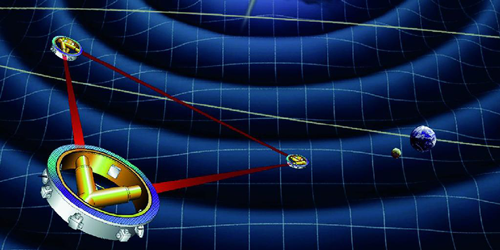Analyzing the Gravitational-Wave Sky
Scheduled for launch in 2037, the Laser Interferometer Space Antenna (LISA) will be sensitive to gravitational waves from many more types of sources than current detectors. Rather than distinguishing individual sources amid that cacophony, a global approach to data analysis may be more practical. Tyson Littenberg of NASA’s Marshall Space Flight Center in Alabama and Neil Cornish of Montana State University have now developed one such approach [1].
LISA’s three constituent spacecraft will trail Earth in its orbit round the Sun in a triangular formation, each spacecraft separated from the other two by 2.5 million km. By directing laser light at each other, the spacecraft will act as a giant three-arm interferometer for detecting gravitational waves. LISA’s sweet spot is the millihertz band, which abounds in sources. Some types are expected, such as supermassive black hole binaries. But other, more exotic sources could show up, including gravitational waves generated during cosmic inflation.
The LISA team recognized the data-analysis challenge and created a simulated dataset made up of likely galactic and extragalactic sources plus detector noise. Littenberg and Cornish used that dataset to test their system, dubbed GLASS (Global LISA Analysis Software Suite). GLASS is based on a method called blocked Markov chain Monte Carlo. As GLASS chomps through data, it varies certain parameters within a range—a block—while the rest are held constant until a global fit is obtained. The blocks correspond to expected source types. Researchers need to vary hundreds of thousands of parameters to obtain such a fit.
GLASS successfully characterized the sources in the dataset, as well as the background noise. Further refinement is needed, however, both to extend the range of potential sources and to shorten the five-day run time.
–Charles Day
Charles Day is a Senior Editor for Physics Magazine.
References
- T. B. Littenberg and N. J. Cornish, “Prototype global analysis of LISA data with multiple source types,” Phys. Rev. D 107, 063004 (2023).




